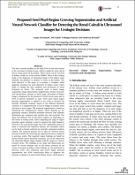Options
Proposed Seed Pixel Region Growing Segmentation and Artificial Neural Network Classifier for Detecting the Renal Calculi in Ultrasound Images for Urologist Decisions
Journal
IJCSI International Journal of Computer Science Issues
Date Issued
2016
Author(s)
Sujata Navratnam
Siti Fazilah
Valliappan Raman
Sundresan Perumal
DOI
10.20943/01201605.6268
Abstract
The most common problem in the daily lives of men and woman is the occurrence of kidney stone, which is named as renal calculi, due to living nature of the people. These calculi can be occurred in kidney, urethra or in the urinary bladder. Most of the existing study in the diagnosis of ultrasound image of the kidney stone identifies the presence or absence of stone in the kidney. The main objective of the paper is to propose a computer aided diagnosis prototype for early detection of kidney stones which helps to change the diet condition and prevention of stone formation in future. The proposed work is based image acquisition, image enhancement, segmentation, feature extraction and classification, whereas in initial stage, ultrasound of kidney image is diagnosed for the presence of renal calculi stone and its level of growth measured in sizes. Seed pixel based region growing segmentation is applied in our work to localize the intensity threshold variation, based on the different threshold variation, it is categorized into a class of images as normal, stone and stone at early stages. The proposed segmentation is based on identifying the homogeneous regions which depends on the granularity features, therefore interested structure with different dimensions are compared with speckle size and extracted. The shape and different size of the grown regions are depending on the entries in lookup table. After completing the stage of region growing, region merging is used to suppress the high frequency artifacts in the ultrasound image. Once the segmented portion of stone is extracted and statistical features are calculated, which can be feed as feature selection by principle component analysis method. The extracted features are in input for artificial neural network classifier for achieving the improved accuracy compared to previous works. The expected output findings are based on texture feature values, threshold variations, size of the stone from the ultrasound kidney image samples with the support of clinical research center. The findings in our study and observation are based on correct estimate size of the stones, position of the stones in location of kidney; these findings are not performed in previous work. The enhanced seed pixel region growing segmentation and ANN classification helps to diagnose the presence or absence of renal calculi kidney stones, which leads to an early detection stone formation in the kidney and improve the accuracy rate of classification.
Subjects
File(s)
Loading...
Name
Proposed Seed Pixel Region Growing Segmentation and Artificial Neural Network Classifier for Detecting the Renal Calculi in Ultrasound Images for Urologist Decisions.pdf
Size
902.07 KB
Format
Adobe PDF
Checksum
(MD5):ae682865b09da78e777447b09e14df65